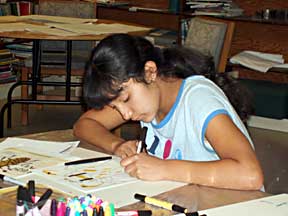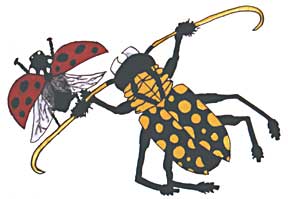|
COVER STORY | IN
THE NEWS | ART
BEAT June 15, 2006Mona's Art Methodby KATHERINE ALMY Summer is upon us and the kids are out of school, so the question now is what to do with them. You know that I'm going to recommend an art class — after all, this is an art column. Two weeks ago the Journal had a great listing of all sorts of things for all sorts of age groups and there were a number of artsy choices. One in particular has had me curious, so I went and checked it out.
Left: Katie Fountain at work. The local franchise is directed by Janice Sharman-Hand. There are classes at the Morris Graves Museum on three levels: an introduction for kids 4 to 5 years old, "Basic Monart" for 6-8 year olds and a mixed media class for those 9 and up. Janice's brochure states that, "just as we learn the ABC's so that we can read ... Monart students learn to perceive what they want to draw in terms of five basic elements of shape." These five basic elements represent "families" of shapes: circles, dots and curved, straight or angled lines. All things, so the theory goes, can be represented with a reasonable degree of accuracy by a combination of the various members of these families. After students are familiarized with the basic shapes they are taught to recognize them in the things they want to draw and to build drawing with them. At this point, you may feel, as I did, a vague sense of discomfort with the idea of taking an intuitive, organic process like drawing and breaking it down into such a nuts-and-bolts system. However, you must bear with me and consider a few points before passing judgment. First there's the notion that art is an ephemeral talent that "just happens" and cannot be taught — part of the myth that artists are some sort of mystical creatures who are not quite like the rest of us. While it may make art seem less glamorous, the fact is, drawing is a skill like cooking or typing, and the mechanics of it are the domain of any living creature with opposable thumbs. I spoke with artist and art educator Nina Groth, who helped develop HSU's Children's Art Academy and taught there for over 10 years. "Everybody can learn to draw with the proper lessons," she said. She's enthusiastic about the Monart method and used elements of it in her teaching.
Right: Lychee Longhorn Beetle with Lady Bug drawn by Sarah Lanning, age 9. But does the method stifle the natural curiosity of a child by asking them to build a drawing from a set of basic shapes rather than drawing from imagination? It certainly could, applied the wrong way. For one thing, timing is important. Younger children are very imaginative and not at all interested in accurately representing what they see around them. (My son draws wild scribbles on his paper and proudly tells me it's a pig.) But every child comes to a point when they see that their drawings do not look like the real thing, and it can be frustrating. That is when a drawing teaching method is appropriate. Janice's students have the tools to create a realistic drawing when that is what they want to do. All of the children that I spoke with are aspiring artists, and they draw and create at home, not necessarily using the methods they've learned in the class. But the point is, they have options: They can choose to create from imagination or draw from life. The Monart drawing method certainly has its detractors. School teachers report that after months of Monart, they see kids who are completely flummoxed when they are asked to draw something from their imagination. This may be simply a result of the system being applied by teachers with no background in art. Having someone well trained in Monart makes all the difference. And in that, we are fortunate. Janice trained with Mona Brooks and has been teaching her method since 1989. She also has an art degree and a single subject teaching credential in art from HSU. Her patience with and respect for her students is obvious and they seem to be thriving under her direction. Is their work museum quality, or will it be? That's not even the point, in my opinion. The Monart website does list success stories of students who went on to be working artists as adults. But even if these kids go on to become computer analysts, the point is that they have spent a lot of time learning to really see the world around them, and that is a skill they will use whatever they do with their lives. Of course, the class is not for everyone — nothing is. It may be worth looking into if your child is interested in art, though. The Monart website is a good place to start (www.monart.com). You'll find a link there to a site for the Eureka school or you can call Janice with questions at 442-9424. Her summer session starts June 26, so you still have some time to get the young Picassos signed up.
Got a local exhibit or art event that might make a good
story? COVER STORY | IN
THE NEWS | ART
BEAT Comments? Write a letter! © Copyright 2006, North Coast Journal, Inc. |


 Monart Drawing School is a franchise
operation focusing on the Monart Drawing Method started by art
educator Mona Brookes in the late '70s. Mona's method emphasizes
the teachability of drawing skills, refuting the idea that draftsmanship
is an innate talent that a few lucky people are born with.
Monart Drawing School is a franchise
operation focusing on the Monart Drawing Method started by art
educator Mona Brookes in the late '70s. Mona's method emphasizes
the teachability of drawing skills, refuting the idea that draftsmanship
is an innate talent that a few lucky people are born with. During a visit
to the drawing class, I talked with the students and they seemed
quite happy to have the process of drawing broken down into simple
lessons. Marijka, an avid student of the arts, says that in other
art classes, the students weren't taught; they were just allowed
to draw. She likes the Monart class because she has a goal to
strive for and she is given the tools to attain it.
During a visit
to the drawing class, I talked with the students and they seemed
quite happy to have the process of drawing broken down into simple
lessons. Marijka, an avid student of the arts, says that in other
art classes, the students weren't taught; they were just allowed
to draw. She likes the Monart class because she has a goal to
strive for and she is given the tools to attain it.